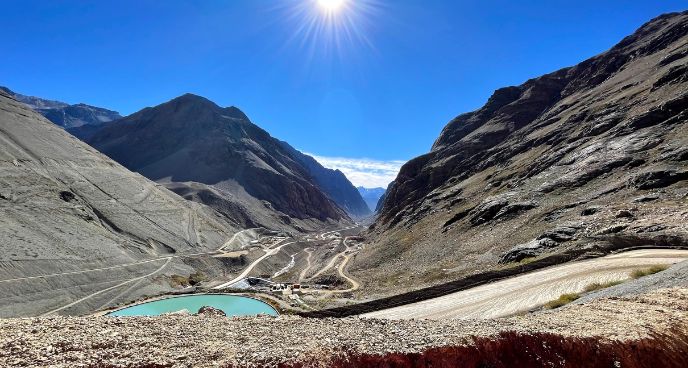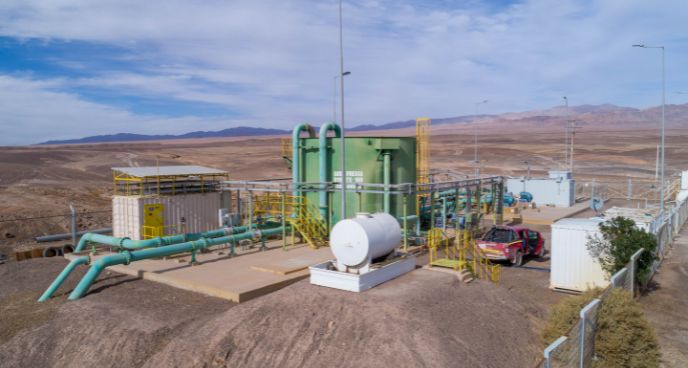
WATER, AN ESSENTIAL RESOURCE FOR MINING IN CHILE
Mining is a water-intensive industry. Its interactions with water resources are very complex and site-specific, with potential impacts on both hydrology and water quality occurring at all stages of a mine’s life cycle. Water needs and impacts change significantly throughout the life cycle of a mine: prior to development, operations, reclamation and post-closure.
Mining is practiced in very diverse hydrological conditions, from the arid regions of central Australia and northern Chile, to the tropics, to the subarctic conditions of Canada and Finland. Local climate and hydrology determine the infrastructure needs of mining operations and profoundly influence the water-related risks faced by mines and nearby populations, ecosystems and industry.
Mining in Chile and its water consumption
According to data from the Mining Council, 5% of the world’s metal mining is carried out in Chile. Mining represents 12% of the country’s GDP, but if we add the economic activity it generates in other sectors, the industry’s contribution to GDP is around 20%. At the regional level, mining contributes 52% to the GDP of the Antofagasta region (Minería en Números 6ª Edición, Consejo Minero [Mining in Numbers 6th Edition, Mining Council]).
Chile’s mining activity takes place mainly in the north-central part of the country, considered one of the driest areas in the world, so water supply has always been a key concern for the industry. In addition, climate change has considerably increased this challenge. The water supply used in mining in Chile comes from surface sources (28%), groundwater (33%), seawater (30%) and third parties (9%).
In terms of technologies, desalination is gaining ground, accounting for 30% of the industry’s water consumption, and is expected to reach 50% by 2030. There are currently eleven desalination plants producing water for mining and seven more in the pipeline. Antofagasta will be the region with the largest number of desalination plants, making it an economically profitable and sustainable region.
Given the scarcity of water in many areas of Chile and Latin America, water reuse has become a key approach to address this issue. Some 76% of the water used in mining processes in Chile is recycled water. Water reuse in mining involves treating and recycling the water used in processes so that it can be reused in the different operational stages. This not only reduces the demand for freshwater, but also contributes to mitigating the environmental impact by reducing water withdrawal from natural sources and contaminated water discharges. Thanks to the development of new
technologies, mining is gradually using less and less water, reducing the level of extraction from inland waters.
 Stages of mining where large amounts of water are required
Stages of mining where large amounts of water are required
As we already know, mining consumes large quantities of water. Water is needed at various stages of operations, such as extraction, processing and transportation of ore, where specialized water services are also required:
- Extraction and processing: Mining involves the separation of valuable minerals and metals from the surrounding rock. This is often done through crushing, grinding and leaching processes, which require water to carry out the necessary chemical reactions. In addition, water is also used to cool and lubricate the machinery used in these stages.
- Transport of minerals: Transporting minerals from the mine site to processing plants or ports may also require water to ensure that the material moves efficiently and smoothly.
- Dust and emissions control: Mining activity can generate dust and suspended particulate matter that can be harmful to human health and the environment. The use of water to suppress dust is common in mining operations to mitigate these negative impacts.
- Acid drainage control: Some mineral deposits may contain sulphides that, when exposed to air and water, can generate acid drainage, which is highly polluting to surrounding water bodies. The use of water in the management of these wastes is essential to control and neutralize the effects of acid drainage.
- Cooling and power generation: Mining operations often require cooling for equipment and machinery, as well as for power generation in thermal power plants. Water is an essential element in these processes.
Advanced technologies
Because water is needed at different stages in mining processes, there are different technologies for water treatment, either for process water or wastewater.
Among them are wastewater treatment systems using activated sludge, a type of biological treatment used to remove organic matter and other contaminants from wastewater.
For drinking water plants, one of the key components is the filter system that is used to remove suspended particles and other impurities present in the raw water, converting it into high-quality drinking water.
Reverse osmosis is a water purification process that uses semi-permeable membranes to remove a wide range of contaminants, including salts, minerals, organic matter and suspended particles.
This technology is especially useful in the mining industry to treat saline water, industrial wastewater and other contaminated water sources.
Seawater desalination is a crucial process in the mining industry, especially in regions where access to freshwater is limited and there is heavy reliance on seawater for operations. This process converts saline water into potable and usable water, as well as water for industrial processes.
Brackish water is less saline than seawater, but more saline than freshwater. In the mining industry, brackish water often needs to be treated to make it suitable for various applications, including human consumption, mining operations and other industrial processes.
Finally, membrane bioreactors (MBR systems) are advanced wastewater treatment systems that combine biological processes with solids separation using semi-permeable membranes. This technology is used in the mining industry to treat wastewater generated during mining processes, reduce the pollutant load and produce high-quality effluent.

Qualified personnel for mine water management
In mining projects, there is usually a regulation to comply with in terms of safety. Usually, mining regulations ask for staff to have the qualifications required for the activity involved. For this type of service, for the different fields that we hire personnel, such as mechanical or electrical maintenance, people with degrees or professional technicians are needed; in addition, there are some additional qualifications as per Chile’s government authority regulating electricity and fuels (Superintendencia de Electricidad y Combustibles). These services also involve the movement of materials, for which we require technicians with a professional driver’s license for the use of machinery.
On the other hand, occupational health and safety professionals are required, depending on the type of services and the risk involved in the operation of these services to people or the environment. These must be professionals accredited by the National Health Service or the National Geology and Mining Service.
Almar Water Services Latam
Almar Water Solutions specialises in the development, financing, operation and management of water assets worldwide. In Chile, through our subsidiary Almar Water Services Latam, we manage water services for mining clients, offering several significant advantages:
- Specialized expertise: Almar Water Services Latam has extensive experience managing water resources in challenging environments. We understand the complexities and specific needs of the mining industry, allowing us to design customized and efficient solutions.
- Regulatory knowledge: The mining industry is subject to a number of environmental regulations and standards that must be met. As a specialized water management company, we are aware of these regulations and work to ensure that water services meet all legal and environmental
requirements. - Water use optimization: Almar Water Services Latam has the expertise to assess and optimize water use in mining operations. This includes identifying opportunities for water reuse and recycling, which can reduce freshwater demand and minimize environmental impacts.
- Advanced technology: We have advanced water treatment and monitoring technologies. This allows for more efficient and accurate management of water resources, ensuring that water is properly treated and maintained in optimal conditions.
- Risk reduction: Improper water management can lead to risks such as water contamination, regulatory penalties and reputational damage. Almar Water Services Latam works to minimize these risks by implementing sound water management and treatment practices.
- Innovation: We offer new and creative solutions to address the specific challenges of the mining industry, which can result in greater efficiency and sustainability.
- Focus on sustainability: Sustainable water management is essential to the future of the mining industry and the environment in general. Almar Water Services Latam understands the importance of balancing operational needs with water conservation and will work towards a more sustainable approach.
Choosing Almar Water Services Latam to manage water services for mining clients means choosing experience, regulatory knowledge, advanced technology and a focus on sustainability. This can translate into more efficient management, risk reduction and a positive environmental impact,
benefiting both mining operations and the environment in which they operate.

